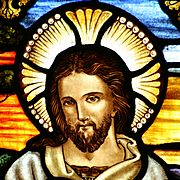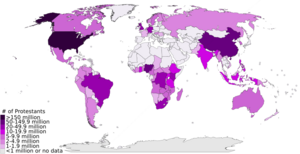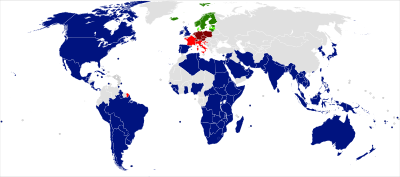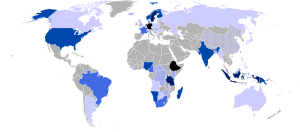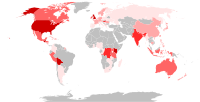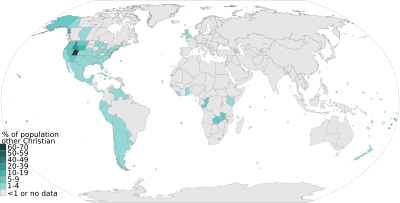List of Christian denominations by number of members facts for kids
How Christians around the world are grouped: Catholic (50.1%) Protestant (36.7%) Eastern Orthodox (9.4%) Oriental Orthodox (2.5%) Other Christian (1.3%)
This article lists the different groups, or denominations, within Christianity by how many members they have. These numbers are often based on what the groups themselves say, so they are good estimates but might not be exact. This article is always being updated!
Christianity is the largest religious group in the world. In 2020, it had about 2.3 to 2.6 billion followers.
Contents
- Christian Families: How They Grew Apart
- Christianity: Over 2.3 Billion Members
- Catholicism: About 1.3 Billion Members
- Protestantism: 800 Million to 1 Billion Members
- Eastern Orthodoxy: 220 Million Members
- Oriental Orthodoxy: 62 Million Members
- Non-Trinitarian Restorationism: 35 Million Members
- Nestorianism: 0.6 Million Members
- See also
Christian Families: How They Grew Apart
Christianity started in the first century AD, after the Roman Empire had taken over many lands. The Roman Empire had different languages and cultures, like Latin in the West and Greek in the East. Early Christians also spoke languages like Coptic in North Africa and Syriac in the Near East.
The early Christian Church faced tough times, with people being treated badly by the government. But in 313 AD, Emperor Constantine the Great made Christianity legal. After this, Christians could finally think more deeply about their beliefs. They had some big disagreements, especially about who Jesus Christ was and how he related to God the Father and the Holy Spirit.
To solve these disagreements, leaders held big meetings called Ecumenical Councils. The first two important councils, at Nicaea and Constantinople, created the Nicene Creed. This creed became a key statement of Christian beliefs.
However, later councils led to big splits. At the Council of Ephesus in 431 AD, the Church of the East separated. Then, in 451 AD, after the Council of Chalcedon, the groups now known as the Oriental Orthodox Churches also went their own way.
Much later, in 1054 AD, a major split happened between Christians who spoke Greek and those who spoke Latin. This was called the Great Schism. The Greek-speaking Christians became the Eastern Orthodox Church, and the Latin-speaking Christians became the Catholic Church.
Starting in 1517, the Western Church saw another huge change called the Protestant Reformation. Many Christians disagreed with the Pope's authority and formed new groups. These groups are broadly called Protestant. They include Lutheranism, Calvinism, Anabaptism, and Anglicanism. Protestantism has many thousands of different denominations today.

Christianity: Over 2.3 Billion Members
Catholicism: About 1.3 Billion Members
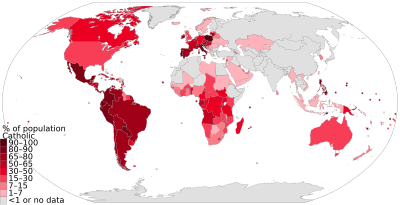
Catholicism is the largest group within Christianity, with about 1.345 billion members. The Catholic Church is the biggest single church. These numbers are from 2019. This total does not include other groups that call themselves Catholic but are not officially part of the Catholic Church.
Eastern Catholic Churches: 18 Million
These churches are part of the Catholic Church but follow different ancient traditions and worship styles, often from the East. They include groups like the Ukrainian Greek Catholic Church and the Maronite Church.
Independent Catholic Groups: 18 Million
These are various Christian groups that call themselves Catholic but are not connected to the main Catholic Church led by the Pope. Examples include the Philippine Independent Church and the Apostolic Catholic Church.
Protestantism: 800 Million to 1 Billion Members
Protestantism is the second largest group of Christians. It includes many different churches. The exact number of members varies, but it's usually estimated to be around 900 million. This group includes Anglicans, Baptists, Lutherans, and many others.
Historical Protestant Churches: 300–500 Million
These are churches that came from the original Protestant Reformation in the 1500s.
Anglicanism: 110 Million
Anglican churches have about 110 million members. Most are part of the Anglican Communion, which is the third-largest Christian group in the world. The Church of England and the Church of Nigeria are two of the largest Anglican churches.
Baptist Churches: 100 Million
The worldwide Baptist community has about 100 million members. Baptists believe that people should be baptized when they are old enough to understand their faith, so they don't count children as members. The Southern Baptist Convention is one of the largest Baptist groups.
Lutheranism: 70–90 Million
Lutheran churches have about 70 to 90 million members. The Lutheran World Federation is a large group of Lutheran churches. The Protestant Church in Germany and the Ethiopian Evangelical Church Mekane Yesus are major Lutheran churches.
Calvinism / Reformed Churches: 70–80 Million
Reformed churches, often called Calvinist, have about 70 to 80 million members. This group includes Presbyterianism and other Reformed churches. The Presbyterian Church of East Africa and the Church of Jesus Christ in Madagascar are large Reformed churches.
Methodism: 60–80 Million
The Methodist movement has about 60 to 80 million followers. The United Methodist Church and the African Methodist Episcopal Church are among the largest Methodist groups.
Adventism: 22.7 Million
Adventist churches have about 22.7 million members. The Seventh-day Adventist Church is the largest group in this tradition.
Restorationism: 4.1 Million
Restorationist groups try to go back to the practices of the early Christian church. The Churches of Christ and Christian churches and churches of Christ are major groups here.
Anabaptism: 4 Million
Anabaptist groups include Mennonites, Amish, and Hutterites. They have about 4 million members.
Hussites: 1.2 Million
Hussite churches, like the Moravian Church, have about 1.2 million members. They trace their history back to the reformer Jan Hus.
Plymouth Brethren: 1 Million
The Plymouth Brethren community has around 1 million members.
Modern Protestantism: 400–500 Million
These groups started more recently, mostly in the 20th century. They are often linked to Pentecostalism or other independent Christian movements.
Pentecostalism: 280 Million
Pentecostal churches have around 280 million members. They often focus on the Holy Spirit and spiritual gifts. The Assemblies of God is one of the largest Pentecostal groups.
Nondenominational Christianity: 80–100 Million
These are churches that don't belong to a specific denomination. They are very diverse. Calvary Chapel is a large example.
African Initiated Churches: 60 Million
These churches started in Africa and blend Christian beliefs with African cultures. The Zion Christian Church is a major example.
New Apostolic Church: 10 Million
The New Apostolic Church has about 10 million members.
Messianic Judaism: 0.3 Million
Messianic Judaism combines Christian beliefs with Jewish traditions. It has about 0.3 million members.
Eastern Protestant Christianity: 22 Million
These are Protestant churches that have kept some elements of Eastern Christian traditions. The Ethiopian-Eritrean Evangelical Church is a large example.
Eastern Orthodoxy: 220 Million Members
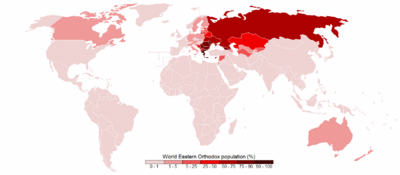
Eastern Orthodoxy has about 220 million members. It is the second largest single Christian group after the Catholic Church. Most Eastern Orthodox churches are in a single communion, meaning they are connected and recognize each other. The Russian Orthodox Church is the largest among them.
Autocephalous Churches: 168 Million
These are independent (self-governing) Eastern Orthodox churches. The Russian Orthodox Church (100 million) and the Romanian Orthodox Church (17–18.8 million) are the largest.
Autonomous Churches: 5 Million
These churches have some self-governance but are still connected to a larger autocephalous church.
Churches with Disputed Independence: 14-21 Million
These churches are recognized as Orthodox by some, but their full independence is still debated by others. The Orthodox Church of Ukraine is an example.
Other Separated Orthodox Groups: 6 Million
These are smaller groups that are not in communion with the main Eastern Orthodox churches, like the Old Believers.
Oriental Orthodoxy: 62 Million Members
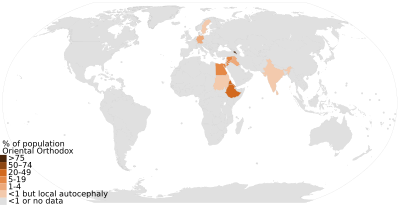
The Oriental Orthodox Churches are different from Eastern Orthodox churches. They separated after the Council of Chalcedon in 451 AD. There are about 62 million Oriental Orthodox Christians worldwide.
Autocephalous Churches: 61.7 Million
These are the main independent Oriental Orthodox churches. The Ethiopian Orthodox Tewahedo Church (37 million) and the Coptic Orthodox Church (10 million) are the largest.
Non-Trinitarian Restorationism: 35 Million Members
This group includes churches that do not believe in the Trinity (God as Father, Son, and Holy Spirit) and aim to restore early Christian practices.
Latter Day Saint Movement (Mormonism): 17 Million
The Latter Day Saint movement, also known as Mormonism, has about 17 million members. The largest church is The Church of Jesus Christ of Latter-day Saints.
Oneness Pentecostalism: 7.5 Million
These Pentecostal groups believe God is one, not a Trinity, but appears in different ways. The United Pentecostal Church International is a major group.
Minor Denominations: 4.4 Million
This category includes various smaller groups like Iglesia ni Cristo and Unitarian Universalism.
Nestorianism: 0.6 Million Members
These churches are part of the historic Church of the East. The main groups today are the Assyrian Church of the East and the Ancient Church of the East.
|
See also
- List of Christian denominations
- List of current Christian leaders
- List of largest church buildings
- List of schisms in Christianity
- List of the largest Protestant denominations
- Major religious groups


